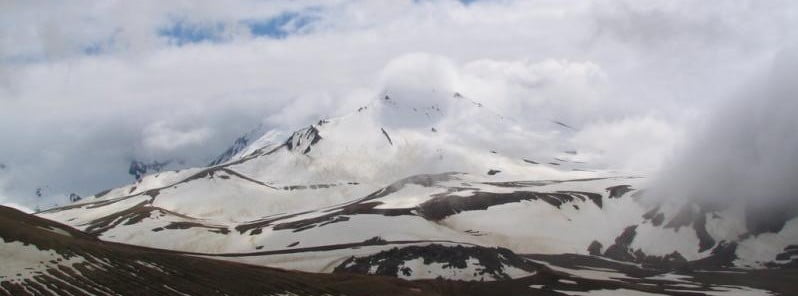Trident volcano – Aviation Color Code raised to Yellow, Alaska, U.S.

The swarm of earthquakes that began on August 24, 2022, beneath Trident stratovolcano, Alaska, U.S. continues. Trident is one of the Katmai group of volcanoes located within Katmai National Park and Preserve on the Alaska Peninsula. The last eruption of this volcano took place in 1974 (VEI 3).
In addition, episodes of weak seismic tremor and low frequency earthquakes have been detected since August 28.
“Together, these observations mean that Trident is exhibiting signs of elevated unrest above known background level. Therefore, we are raising the Aviation Color Code to YELLOW and the Volcano Alert level to ADVISORY,” the Alaska Volcano Observatory (AVO) reports.1
During the current swarm, earthquake depths were initially mostly deep at around 25 km (16 miles) below sea level but became progressively shallower to around 5 km (3 miles) by August 28.
Since then, earthquakes have mostly occurred 3 to 6 km (about 2 to 4 miles) below sea level, although some deeper events have been detected.
Earthquake magnitudes have ranged from 0.7 to 1.9. At the peak of the swarm, dozens of earthquakes occurred daily beneath the volcano, but earthquake rates have since decreased to just a few per day. No other signs of unrest have been detected in monitoring data.
The increase in seismic activity is likely caused by movement of magma or magmatic fluids, AVO said.
Increases in seismic activity have been detected previously at Trident and other similar volcanoes, with no subsequent eruptions.
“We expect additional shallow seismicity and other signs of unrest, such as gas emissions, elevated surface temperatures, and surface deformation to precede any future eruption, if one were to occur.”
Geological summary
The Trident stratovolcano cluster was named for the three prominent peaks that were the most visible features at the summit prior to 1953.
The andesitic-dacitic group consists of four overlapping stratovolcanoes and numerous flank lava domes, including Falling Mountain and Mt. Cerberus on the far west flank.
The summit complex is located 3 – 5 km (1.8 – 3.1 miles) SE of Novarupta volcano, and merges along a ridge to the NE with Katmai.
The three oldest Trident volcanoes are glaciated and Pleistocene in age, while the youngest, Southwest Trident, was formed during historical time.
Eruptions migrated through time from the NE to the SW. In 1953 a new lava dome began growing on the SW flank of Trident I volcano.
A series of thick andesitic lava flows were erupted between 1953 and 1968, forming a cone with 400 – 800 m (1 312 – 2 624 feet) of local relief.
Periodic explosions took place until 1974, and the current summit contains a 350 m (1 148 feet) wide crater.
Some of the distal lava flows from West Trident stratovolcano collapsed into the Novarupta vent during its 1912 eruption.2
References:
1 Trident volcano – AVO/USGS Volcanic Activity Notice – Issued on September 29, 2022
2 Trident volcano – Geological summary – GVP
Featured image: Novarupta dome with Trident behind it. Credit: AVO/UAF-GI, Tilman, M. R.

Commenting rules and guidelines
We value the thoughts and opinions of our readers and welcome healthy discussions on our website. In order to maintain a respectful and positive community, we ask that all commenters follow these rules.